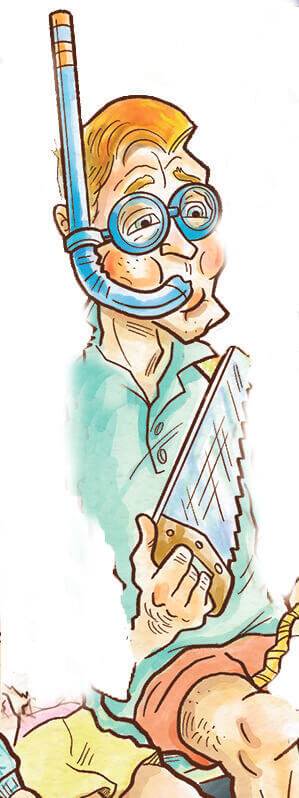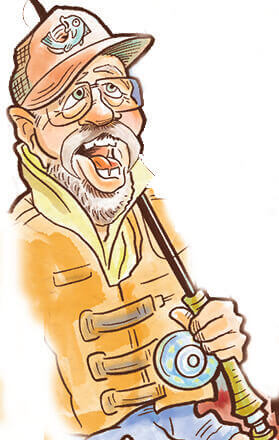No one is immune from a few embarrassing moments on the water, us included. We know because, unfortunately, we’ve made ‘em ourselves.
Illustrations by Charles Akins
Let’s face it. Everybody makes mistakes. Some of us make lots of them. We burn the bacon, forget to lock the front door after leaving the house, totally blow by somebody’s cherished birthday or other milestone, or wander endlessly in the aisles of the supermarket, struggling to remember what it was that brought us there in the first place. And our boats? Well, unfortunately, they’re not exempt from this pesky phenomenon. Not by a long shot.
Indeed, even a bunch of guys who’ve worked for years at marine publications like Power & Motoryacht and Anglers Journal are perfectly capable of occasionally pulling off dumb boat-related head-scratchers. So here, dear reader, are a few choice examples. We hand them over to you now in an attempt to help you avoid some of the embarrassing, expensive and/or even dangerous slipups we’ve made ourselves.
FENDER BENDER
It pains me to admit this, but after leaving my slip one fine morning a month or so ago, I simply forgot to pull in my fenders. And, I suppose, during the jaunt that ensued, nobody pointed this oversight out to me via my VHF radio because boaters are so nice in northern Florida and southern Georgia. At any rate, tragically, the seas were rather sporty that day—sporty enough to cause the upper edge of the big midship fender to rhythmically bounce, slam and rub against the starboard hullside of my boat as she proceeded through the water, thus causing a 2-inch-by-1/2-inch gouge to appear in both the hull’s Awlcraft 2000 acrylic urethane paint and the primer underneath.
Cost of the repair? Still to be determined as of this writing. But it ain’t gonna be cheap, I predict. On the upside, though, this whole awful affair brings up a useful point. Certainly, we’ve all heard the experts tell us that the failure to pull in your fenders is the mark of a lubberly, deplorable neophyte without a brain in his or her head. And yeah, that may be true most of the time. But now and again, such an air-headed little slip-up may also be indicative of a highly experienced, yet temporarily distracted, boater who subconsciously wants to shell out oodles of cash for an impromptu visit to his favoUrite spray-gun-slingin’ boat yard. After an otherwise enjoyable cruise, of course.
HEAR ME ROAR
Even cruising on a fine, comfy vessel can be tiring, especially if you’ve been doing it for hours and hours. So, when we arrived at my marina in Jacksonville, Florida, late that afternoon, I was tuckered out. And I was even more tuckered when, toward the shank of the evening, I finally got back to the boat after driving my cruising buddy many miles north to the airport to catch a plane. Call me crazy, but I then decided, against my better judgment, to wash down the boat before going below to hit the rack. Then, crazier still, I decided to squeeze in one last moonlit project, after the washdown was complete, by hitting the nearby pumpout station for an extraction. The reasoning that bubbled through my absolutely exhausted mind? I’d sleep better knowing the holding tank was empty. So, after cranking up, off I went. And everything was fine, at least for a while. Then, as I neared the pumpout station, the pitch of my old, naturally aspirated, heavyweight diesel changed drastically. In seconds it went from its usual purr to a hoarse, throaty, gut-wrenching roar. “On no!” I muttered as I hit the STOP button and coasted in.
I figured out what had happened while tying up. Prior to the washdown, and in keeping with a long-time habit, I’d closed the seacock for the diesel’s raw-water intake, thinking I’d eventually be leaving the boat unattended for a couple of weeks. Then, in the throes of my nutsy pumpout craze, I’d forgotten all about the seacock and cranked the engine, thereby encouraging it to eventually voice its hearty displeasure at having to run without cooling water.
Damage? Luckily, none. After a long, healthy cool-down I carefully opened the diesel’s seacock, cranked ’er back up, checked the exhaust-water discharge and returned to my slip.
The moral of the tale? Have a startup checklist—a mental one is okay, but printed is better—and always consult the darn thing before you turn the ignition key. And also, know when to quit—working to the point of exhaustion, particularly if you’re going it alone by moonlight, can lead to oversights and perhaps even catastrophe.
UNINTENTIONAL FOUL
Go cruising long enough and eventually you’ll be forced to face a fouled prop. Tangling your prop with your own line—that’s a special kind of pain, but that’s a story for another day. Swimming beneath my boat as she bobbed up and down violently, trying to hack away at a knot with a dull steak knife that I‘d used for dinner the night before, I realized I did not have the right tools for the job. After finally freeing my prop I laid on deck like a wounded flounder. Since that day, I’ve been sure to not leave the dock without goggles (or a mask and snorkel) and a hand saw.
OVERSERVED
I love getting non-boaters out for a day on the water. Experiencing our pastime through the eyes of someone who doesn’t go boating much is a great way to remind yourself of how lucky you are—and to also hopefully create more boaters. Be warned: special consideration needs to be taken when you have crew aboard without any sea legs. The risk of a stumble, misstep or even man-overboard scenario is exponentially higher. Add alcohol into the mix and now you’re really playing with matches. A slight slur and small stumble might be funny on land, but on a boat underway it can end in disaster.
How do I know this? I’m going to refrain from naming names to protect the inebriated, but let’s just say Dark n’ Stormy describes the drink being served and my mood until they were off my boat.

GAS SPILL GALORE
As a college student I spent a summer working as a “houseboat instructor” on Lake Powell in Utah. I taught folks how to use the 50-foot houseboat they had just rented for a week of blissful cruising. This meant showing them how to start the engines, operate the throttles, change a prop, light the water heater and things like that. When an incoming group notified us that they’d be arriving after hours, I offered to stay late and show them the ropes. During the walkthrough, we couldn’t get one of the outboard engines to start. The little fitting at the end of the fuel line where it attaches to the motor was damaged. It wouldn’t seal, and no matter how many times you pumped the ball in the line to prime it, the motor wasn’t getting enough fuel. I told the guests we’d have to wait till morning for a mechanic because I didn’t have access to the shop.
The next morning, when I showed up at the marina, I was greeted with signs saying “Fuel Leak, No Smoking!” and an array of National Park Service vehicles. Turns out the fuel line, which I had taped to the motor, had fallen off, and fuel had dribbled into the harbor all night long, causing the largest fuel leak of the summer. I felt horrible and helped set out booms to contain the fuel. I had to fill out a very long accident report and nearly lost my job, but in the end I was freed of any wrongdoing as it was truly a mistake, and one I’ll never repeat.
ANCHOR’S AWAY
The Cape Canaveral Bight sits just north of a busy port inlet in central Florida. It’s a great spot to fish for Spanish mackerel, pompano, redfish and speckled sea trout. The area is a protected national seashore with just a few NASA buildings and some rocket launchpads. I was fishing the Bight with a buddy on his 21-foot Key West center console, casting shrimp and artificial lures toward the beach. We were staying just offshore of the surf break and working areas of clean water, hoping for pompano. We kept the outboard running so we could bump it in and out of gear to keep us from getting too close to shore. Then, the motor died and we couldn’t get it to restart.
The swells began pushing us closer to the beach, and I started to get nervous. I was fishing from the bow and my instinct told me to open up the anchor locker and toss the anchor out, which I did. But this wasn’t my boat. And the brand new anchor I had just tossed over had yet to be attached to the anchor line. Lucky for us, the engine kicked to life just as we were about to get beached, and my buddy floored it to move us out of the surf break to calm water. We made a pit stop at the marine store on the way home and I replaced his anchor.

Seeing the Light(ning)
“It’s just heat lightning,” I told my fishing partner. “It’s nothing.”
As kids, we pretty much ignored these distant flashes of summer lightning. On this evening in August, my future son-in-law and I were fishing for striped bass behind Fishers Island, New York, when the sky to the east flashed repeatedly with lightning and no thunder.
I’d checked before we’d headed out that evening and saw no reports of any weather problems. The marine forecast called for light winds from the southwest. It was a typical summer forecast, perfect for taking a small boat behind the island and casting live eels along the rocky shores.
The fishing was just good enough to keep us fishing longer than we might have. Every time I thought about calling it a night, we’d get another fish and decide to stay a little longer. The temperature was mild—we fished in shorts and T-shirts and talked Red Sox and fish. These were home waters, and this kind of fishing was something I’d done for years.
Still, the pyrotechnic show to the east was unsettling. Lightning reflected off the clouds like ragged strobe lights. It was captivating but put me on edge. Still no sound of thunder.
It was a wind shift that caused me to pack it in. We put the rods in the holders, turned on the running lights and headed for the east end of the island, several miles away. Things happen faster at nighttime on the water.
The gusts I’d felt were the first downdrafts from a line of fast-moving thunderstorms that battered summer anchorages along eastern Long Island Sound that night, causing boats to drag their anchors and wind up on the hard.
The wind built quickly as we worked our way east. The tide was flooding, which meant we’d be looking at wind against tide once we exited the narrow passage between Fisher’s Island and the low, rocky, current-swept Wicopesset Island.
I stopped my vintage 17-foot Boston Whaler Nauset a quarter mile shy of the passage and stowed all lose gear that was on the deck. I put on a lifejacket and had my partner Dan do the same. I knew it was going to be bumpy and wet. His job was to hang on and shine the spotlight as directed.
I remember thinking: I can’t lose my daughter’s fiancé. She’ll never forgive me. Once we turned east for Watch Hill, the steep waves and wind on the bow made it clear that we weren’t going home in that direction. We took two waves over the bow, which convinced me to change course to avoid flooding the boat.
I fell off the wind before we could hit a third wave, putting the seas and gusts on my starboard quarter as we headed north for calmer waters. When things settled down, I cleaned my glasses of spray, zoomed in the GPS and set a new course for home.
Lessons? Sometimes the long way home is the safest course. Don’t let old weather clichés put you in harm’s way. Listen to your instincts. And adjust quickly to changing conditions. Most importantly, remember, that small boats must bend and work with the wind and seas, not bash into them head-on.

CHECK THE SALINITY
As a young captain I had the opportunity to cruise to Europe and spend nine months bouncing around the Mediterranean, a great adventure that I wouldn’t mind having again, if I could afford it. But my youthful infatuation with being in charge led me to overlook some basic maintenance chores that eventually precipitated a pile of very substantial repair bills.
What happened? You might not know, as I didn’t, that the Mediterranean Sea is saltier than the waters of the U.S. East Coast, my usual stomping grounds, and of the Atlantic Ocean in general. It has to do with evaporation of water from the Med due to the warm climate; water lost to the atmosphere leaves its salt behind, so over the past five million years or so, the Med has become substantially salty. This increased the rate of galvanic corrosion of various components of my boat, including the zincs in the engine’s heat exchanger, which were eaten up by sea water much faster than usual. Once the zincs were gone, the Med water started consuming the innards of the heat exchanger. I noticed something was amiss when the water level in the tank kept rising—overflowing at times. There was also a salty track running from the overflow tube down the front of the tank, which for some reason didn’t bother me. The engine kept running okay, though—but my inattention turned it into my very first saltwater-cooled diesel!
When we stopped in Mallorca for a quick refit and repair of another engine issue before heading back home, the mechanic pointed out the result of my ignorance, adding, “We see that a lot in boats from the U.S.” The only thing that saved me was another engine failure—not my fault this time—that necessitated an engine rebuild. The cost of the new heat exchanger was absorbed by the bigger problem, and I escaped with only a few self-administered kicks in the butt for not paying attention to maintenance.

WATCH THE CURRENT
I spent a year aboard a small tanker working in New York -Harbor, where I learned a lot about boat-handling while making some nearly catastrophic errors. A commercial boat’s rugged construction, massive rubrails and excessive fendering make it forgiving of mistakes: You can take a good whack and bounce off undamaged—at least most of the time.
One day, in a commercial ship basin full of empty barges in -Bayonne, New Jersey, I forgot one of the basic boat-handling rules: check the current before casting off. As the Old Man, an Irishman with a thick County Cork brogue (who owned the boat but didn’t like to steer) turned loose of the final bowline, the current caught us and almost immediately swept us crossways toward one of the biggest, ugliest, most intimidating barges I’d ever seen.
Before I realized it, we were under its lofty overhanging bow. The rubrail wouldn’t help—the pilothouse was in harm’s way.
“Mikel,” said the Old Man. “Do ya see that barge?”
See it? It blocked out the sun! No time for finesse: My only chance was to yank the 6-71 into reverse and hit the throttle.
For a while, a combination of prop walk, clean living and dumb luck looked like it would save me—but then the pilothouse just touched the corner of the barge. Twang! I felt the pilothouse shudder. The Old Man never said a word until we got back to our dock. “Better see if you did any damage.”
Not a mark on the top of the house, but along the base, where the wooden structure was secured to the steel deck of the boat, several fastenings had obviously pulled through. When I looked closer, however, I saw the damaged wood was gray with age. This hadn’t happened an hour ago, but years ago; I wasn’t the first one to get in a jam like this—must have been the Old Man having a bad day, way back before I signed on. But I learned my lesson—never, never maneuver around anything you can hit without checking the current. It can sneak up and bite you.
NEVER LEAVE THE BOAT
One cold October day we set out to move the boat from eastern Long Island to New York City, but the seas in Long Island Sound were too steep for comfort thanks to a cold autumn wind. We backtracked to Three Mile Harbor near East Hampton to wait out the weather. During our docking, with the owner at the helm, the wind caught the bow and blew it toward a low floating dock. I jumped off the boat to fend off but miscalculated how low the dock actually was. In a trice, I found myself staring at the rubrail, barely able to reach the bowrail to pull myself back aboard. I was fully togged out in cold-weather gear—two sweaters, wool pants, full foul-weather gear and white sea boots (like those worn by commercial fishermen) rather than Top-Siders.
Jumping back aboard while pushing the bow away from the dock would have been a feat for Simone Biles in a leotard—for me, dressed like a damp Michelin man, it wasn’t gonna happen. But I gave it my best shot: I kicked my legs up toward the gunwale with all my might, missed by at least a foot, and ended up hanging off the bowrail like a character in a Looney Tunes cartoon.
I suggested to the owner that he pull back to the dock and drop me off, but he was too busy laughing to do so. As luck would have it, this horrible event took place in my home harbor, so 90 percent of the folks watching knew me—and it was a Sunday morning—there was a big crowd.
Finally, to end the agony, I dropped into the water and backstroked to the dock. A friend of my dad’s, a burly carpenter who’d spent his whole life hammering and had the arms to show for it, stuck his jelly donut into his mouth and rolled me onto the dock, while taking care not to spill the coffee in his other hand. The owner shifted the boat to another, taller dock where we tied up for the night, and I had to endure an hour of commentary from folks I once called friends, while buying them all fresh cups of coffee.
The moral of the story? Never leave the boat until it’s tied to the dock—but if you do, do it in a place where nobody knows you.
This article originally appeared in the November 2021 issue of Power & Motoryacht magazine.




